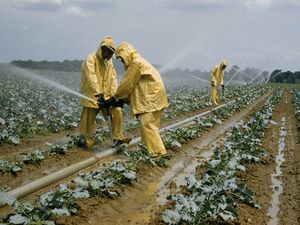Agriculture
Agriculture is the practice of farming, including cultivating crops, raising animals, and producing food, fiber, and other products to sustain human life. Agriculture is a fundamental part of human civilization and has evolved over thousands of years to meet the needs of growing populations, different ecosystems, and different cultures. Modern agriculture has become more advanced with the use of technology and machinery. The creation of genetically modified and hybrid crops has increased yields and efficiency.
History
Before agriculture, humans were hunter-gatherers who traveled nomadically. Roughly 10,000 years ago, humans learned how to domesticate animals and cultivate plants in a single area. This allowed humans to have a more stable and consistent food supply, increasing survival rate and population size.
The first known agricultural settlement is in what is known as Iraq, Syria, Turkey, and Iran. This area was nutrient-rich and fertile soil, called the Fertile Crescent. In the 1700s and 1800s, there were massive developments in technology in agriculture which could increase productivity and efficiency. Some of these technologies included plows. New practices were also adopted that improved the quality of the crop, such as crop rotation and hybridization of plants. Later, they did the same with livestock by breeding them to grow bigger and faster.
Types of Agriculture
Environmental Impacts

Pesticides
Pesticides are intended to kill insects of certain crops, but there is a domino effect when a pesticide application is used. Nontarget species can be affected, such as pollinators. Human health can be impacted. This can also make past resistance more catastrophic when the pause of the side doesn't work.
Water Quality
One element produced in agriculture is phosphorus, and when it enters water streams, it inhibits algal growth. Algae can sometimes be beneficial, but it's requestors a lot of oxygen and can create dead zones and produce harmful algae such as cyanobacteria.
Crop Modification
Plant Breeding
Selective breeding of plants is when you take animals with specific traits and breed them to increase and improve those traits. For example, plants can be produced to be resistant to pests and diseases, easier to cultivate, immune to certain temperatures, etc.
Livestock Breeding
Selective breeding of livestock is when you take animals with specific traits and breed them to increase and improve those traits. For example, animals can be produced to be larger, meatier, disease resistant, etc.
References
Agriculture. 2023, March 31. Wikipedia.
Gjedrem, T., N. Robinson, and M. Rye. 2012. The importance of selective breeding in aquaculture to meet future demands for animal protein: A review. Aquaculture 350–353:117–129.
Tudi, M., H. Daniel Ruan, L. Wang, J. Lyu, R. Sadler, D. Connell, C. Chu, and D. T. Phung. 2021. Agriculture Development, Pesticide Application and Its Impact on the Environment. International Journal of Environmental Research and Public Health 18:1112.